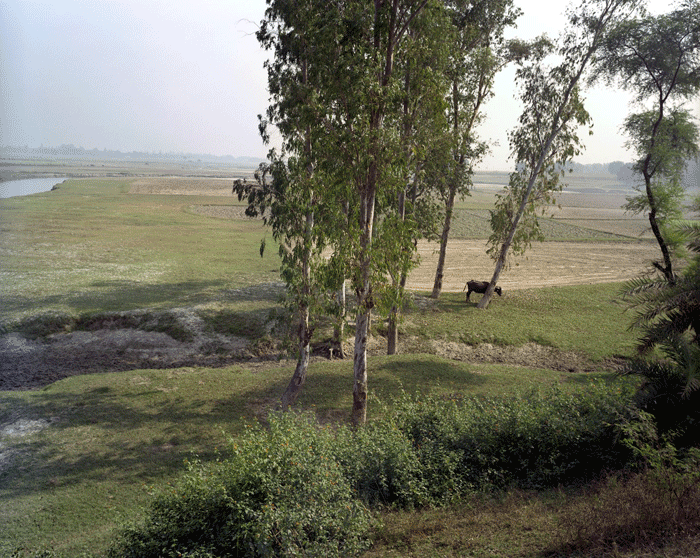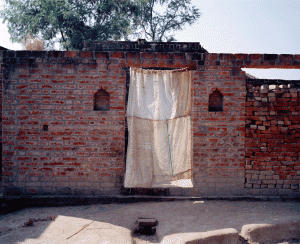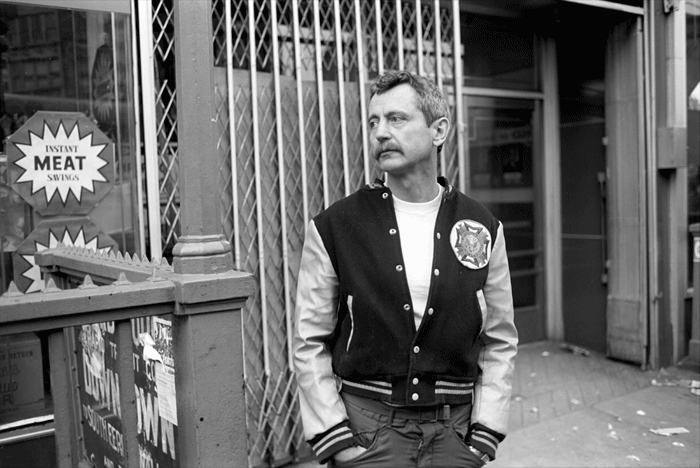Untitled, 20062011 (negative); 2015 (print). Sunil Gupta, Canadian (born India), active London and Delhi, born 1953. Inkjet print, Image: 17 7/8 × 22 inches, Philadelphia Museum of Art, Picture This: Contemporary Photography and India
Picture This: Contemporary Photography and India, Sunil Gupta
“Sunil Gupta is an artist-activist. Since the 1970s, he has explored the politics and experience of gay life in terms of his own identity as an HIV-positive Indian man living and working between Canada, the US, England, and India. He is represented by unflinching images from the beginning of his career, including the 1976 Christopher Street series shot in New York’s West Village, to an ongoing series, originating in 2006, dealing with Gupta’s contradictory emotions around his family’s ancestral village and the death of his father.” – PMA press release
Picture This: Contemporary Photography and India explores facets of art and identity through photography, persistent memes of the idea of India are explored throughout the space connecting expectations with reality. Sunil Gupta is my contemporary, we are the same age and we were both drawn to New York City and Christopher Street. Luckily, I had a friend who lived in the only high rise on the historic street, the epicenter of gay life, partying at the clubs, dancing until dawn, then wandering the streets at night. The Trucks, the piers, the baths, and the clubs, hedonism was in like aviator shades and mustaches. I remember the first time I heard about the strange disease going around, I’m forever grateful to the handsome stranger who made me aware that my behavior could be dangerous.
Since Sunil Gupta and I are contemporaries, we probably partied at the Eagle or cruised Jones Beach at the same time. When I saw Gupta’s photograph of the iconic gay guy on the street with sunglasses, porn star mustache, and bulge in his jeans, I was transported through time and space to a place in my mind I keep private. I’ve been out for a long time, I did however fall in love with and marry a woman, and I experienced first hand the privileges of straight society. The photographer was faced with the same challenges as me except he could not live openly as a gay man in India. If he were to go home his choices for self realization as an artist and an individual would be severely restricted.
“Homophobia is prevalent in India. Public discussion of homosexuality in India has been inhibited by the fact that sexuality in any form is rarely discussed openly. In recent years, however, attitudes towards homosexuality have shifted slightly. In particular, there have been more depictions and discussions of homosexuality in the Indian news media and in Bollywood. Several organisations, including the Naz Foundation (India) Trust,[7] the National AIDS Control Organisation,[7]Law Commission of India,[8]Union Health Ministry,[9]National Human Rights Commission of India[10] and the Planning Commission of India[11] have expressed support for decriminalising homosexuality in India, and pushed for tolerance and social equality for lesbian, gay, bisexual, and transgender people. India is among countries with a social element of a third gender. But mental, physical, emotional and economic violence against LGBT community in India prevails.[12] Lacking support from family, society or police, many gay rape victims don’t report the crimes.” – Wikipedia
“When Sunil Gupta went to New York in the mid-1970s, as far as I know he had already come out to his parents. I think when you say “he could not tell his family he was gay,” the spirit of that statement is right in the sense that the life he was building for himself did not fit with the cultural traditions and values that shaped his family. It’s also right to say that he couldn’t have built the life he wanted in India. However, his parents lived in Montreal, Canada at the time, so the question of what would be “going home” is not as simple as heading back to Delhi. (This kind of peripatetic complexity is part of what makes Gupta’s perspective so interesting and important.)” – Nathaniel M. Stein, Curator
Untitled, 20062011 (negative); 2015 (print). Sunil Gupta, Canadian (born India), active London and Delhi, born 1953. Inkjet print, Image: 17 7/8 × 22 inches, Philadelphia Museum of Art, Picture This: Contemporary Photography and India
Talking with curator Nathaniel M. Stein, Horace W. Goldsmith Curatorial Fellow in Photography, I mentioned I had heard about the efforts being made to bring basic sanitation to rural India. The beautiful landscape photo encapsulated my inner view of where people go in the morning to defecate as explained in the radio show. The practice is ancient but presents obvious health risks which damage generations of people. Nathaniel nodded in agreement, “This is where the bad things happen, too.”
The photograph above signifies the homestead that Sunil was expected to inherit and maintain, the property was modernized with an outhouse. Several of the photographs display a sweet nostalgia for home but Gupta’s self portrait reveals the man and his desire to live a life of self determination. I empathize with his struggle to meet traditional family values and responsibilities versus individuality. Nathaniel Stein explains the generation gap shown in the photographs:
“The Country: Portrait of an Indian Village series does include an image made inside the courtyard of Gupta’s own family’s house. However, just to be clear, the image you posted in your blog is not the Gupta family house. Rather, it’s the exterior of a different house in the same village. The picture is taken from the street outside the house, looking towards an entryway that is closed to our view by hanging fabric. Together the two pictures might be thought of as symbolic in the sense that the artist is reflecting on what it means to be simultaneously close to something and separated from it, on the inside and the outside – of a domestic structure, most obviously, but also of traditions, relationships, economic or social positions, etc.
The outhouse pictured in another print from Country: Portrait of an Indian Village is not directly related to the brick courtyard house. It’s part of a social welfare project organized by one of Sunil Gupta’s relatives, to provide facilities for local people who would not otherwise have a sanitary (or, sometimes, safe) place to relieve themselves. To me this image is important in the series because it connects Gupta’s reflections on his own complicated social position to his awareness of the social positions of other people who live in the village and are also socially disenfranchised, though for different reasons than the artist. Politically, Gupta recognizes connections between many forms of marginalization.” – Nathaniel M. Stein, Curator
“Sunil Gupta (Canadian, b. 1953, New Delhi, India) is among India’s best-known living photographers. He is an artist, writer, activist, and curator who lives and works in London and Delhi. Gupta’s work has been presented in over ninety international solo and group exhibitions. Educated at Concordia University, Montreal; The New School for Social Research, New York; and the Royal College of Art, London, his publications include three monographs Pictures From Here (2003), Wish You Were Here: Memories of a Gay Life (2008), and Queer: Sunil Gupta (2011).” – PMA press release
Untitled, 1976. Sunil Gupta, Canadian (born India), active London and Delhi, born 1953. Gelatin silver print, Image: 15 5/8 × 19 1/2 inches, Philadelphia Museum of Art, Picture This: Contemporary Photography and India
Curator: Nathaniel M. Stein, Horace W. Goldsmith Curatorial Fellow in Photography
Location: Julien Levy Gallery, Perelman Building, Philadelphia Museum of Art, 2600 Benjamin Franklin Parkway, Philadelphia, PA 19130
215-763-8100
Exhibition hours: Tuesday–Sunday, 10:00 a.m.–5:00 p.m through April 3, 2016.
Social Media:
Facebook and Twitter: philamuseum
Tumblr philamuseum
YouTube PhilaArtMuseum
Instagram @philamuseum
Read the press release for Picture This: Contemporary Photography and India at DoNArTNeWs
Written by DoN Brewer except where noted. Images courtesy Philadelphia Museum of Art
Like DoNArTNeWs Philadelphia Art News Blog on facebook
Follow DoN on Twitter @DoNNieBeat58
DoNArTNeWs on Tumblr
@donniebeat on Instagram
More DoNArTNeWs at www.brewermultimedia.com
Affiliate Marketing Disclosure Statement
Donate via safe and secure PayPal in the sidebar.






{ 0 comments… add one now }
You must log in to post a comment.
{ 1 trackback }